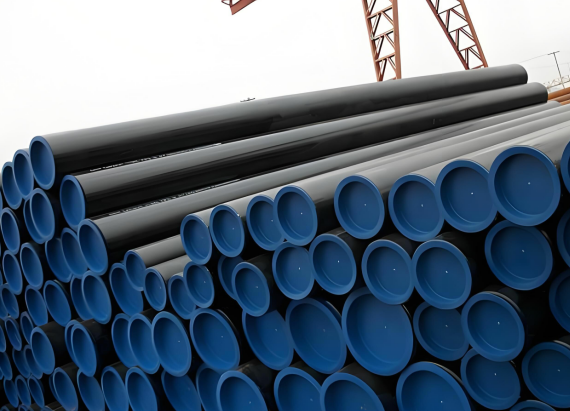
API 5L Grade B Pipe Specification
API 5L, the American Petroleum Institute's (API) line pipe specification, is widely used in pipeline transportation systems across the global oil and gas industry. This specification covers both seamless steel pipe and welded steel pipe, and is intended to provide standards for pipelines transporting natural gas, water, and oil. Grade B pipe is a key steel grade within this specification, with two product specification levels: PSL1 and PSL2. PSL2 has more stringent requirements for chemical composition control, mechanical property testing, nondestructive testing, and quality traceability.
Key technical parameters
1. chemical composition
Carbon (C): ≤0.28%. This must be kept within a reasonable range to ensure strength while avoiding compromised toughness and weldability due to excessive levels.
Manganese (Mn): ≤1.20%. This improves the strength and toughness of steel while mitigating the harmful effects of sulfur.
Sulfur (S) and Phosphorus (P): Both ≤0.03%. As harmful elements, they can weaken steel's toughness and corrosion resistance, and therefore their contents are limited.
Copper (Cu), Nickel (Ni), Chromium (Cr): All ≤0.50%; Molybdenum (Mo): ≤0.15%. These elements enhance the corrosion resistance and overall performance of steel pipes.
2. Mechanical properties
API 5L Grade B steel pipe has a yield strength of no less than 245 MPa. This means that within this stress value, the steel pipe will maintain elastic deformation, while above this stress value, it will begin to deform plastically. This high yield strength ensures that the steel pipe does not easily undergo permanent deformation when subjected to pressure. The tensile strength is no less than 415 MPa, reflecting the steel pipe's ability to resist tensile failure and ensure it will not easily break under tension. The elongation is typically no less than 23%, reflecting the material's ability to undergo plastic deformation before breaking under tension. This high elongation allows the steel pipe to withstand a certain degree of deformation during installation and use without breaking, ensuring the safety and reliability of the steel pipe in actual use.
Dimensions and tolerances
1. Size range
API 5L Grade B steel pipes come in a variety of sizes and specifications, with common pipe diameters ranging from 1/8 inch (DN6) to 48 inches (DN1200), which can meet the pipe diameter requirements of different projects. The wall thickness size is based on the ASME B36.10M standard. Common wall thickness grades include SCH 10, SCH 20, SCH 40, STD, XS, SCH 100, SCH 120, SCH 160, XXS, etc. Different wall thickness grades are suitable for different pressures and working conditions. For example, in high-pressure transmission scenarios, thicker wall steel pipes will be selected to ensure the strength and safety of the pipeline.
2. Tolerance requirements
API 5L Grade B steel pipe has strict regulations regarding dimensional tolerance control. For outer diameter (OD) tolerances below 60.3mm, the tolerance range is +0.41mm/-0.40mm; for ODs ≥ 60.3mm, the tolerance is +0.75mm/-0.40mm. For wall thickness tolerances below 73mm, the tolerance range is +20%/-12.5%; for ODs ≥ 73mm, the tolerance range is +15%/-12.5%. Strict control of these tolerances is crucial. Only precise dimensional tolerances can ensure the sealing and connection stability of pipeline systems, avoid leaks and loose connections caused by dimensional deviations, and guarantee the safe and stable operation of oil and gas pipeline projects.

PSL1 vs. PSL2
Differences in Inspection Requirements
PSL1: Basic inspection, including tensile testing (measuring yield strength, tensile strength, and elongation), chemical composition analysis (controlling the content of elements such as carbon and manganese), and dimensional inspection (diameter and wall thickness tolerances) to ensure that basic performance meets standards.
PSL2: More stringent requirements, covering all PSL1 items, and adding impact testing (Akv value at 0°C must meet the standard, such as ≥41J in the longitudinal direction for non-X80 steel grades), drop weight tear test (DWTT), hardness testing, and metallographic examination to fully ensure toughness and tear resistance.
Different Application Scenarios
PSL1: Suitable for conventional environments, such as city gas feeder lines and short-distance, low-pressure water and gas transmission projects. It offers low costs and meets basic requirements for stable operating conditions.
PSL2: Suitable for complex and demanding scenarios, such as deep-sea oil and gas extraction, pipelines in extreme climates like the Arctic, and the corrosive environments of chemical parks. Its high resilience and risk resistance ensure safety.
API 5L Grade B Pipe is most common use material
API 5L Grade B, ASTM A106 Grade B and A53 B, these three are most common use material for the industries where refers pipeline construction or oil and gas, liquid transmissions.
ASTM 106 pipe refers to the carbon steel pipe manufactured in hot rolled or cold drawn (rolled) seamless.
ASTM A53 pipe covers welded and seamless steel pipe, in carbon black material and some cases in hot dipped galvanized (zinc coated).
Conclusion
The API 5L Grade B pipe specification is a key criterion for ensuring steel pipe quality and performance. Its strict regulations on chemical composition, mechanical properties, dimensional specifications, and tolerances provide a solid foundation for safe and stable operation under diverse operating conditions. Two product specification levels, PSL1 and PSL2, are designed for use in applications with varying degrees of severity, meeting diverse engineering needs.
Read more: APl5L Line Pipe-PermanentSteel.com
- 【Prev】 : Seamless Steel Pipe for Tunnel
- 【Next】 : Seamless Steel Pipe for Fire Hydrant Pipes


